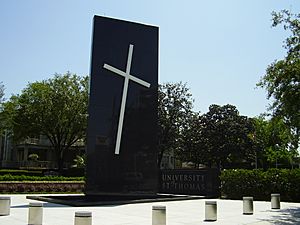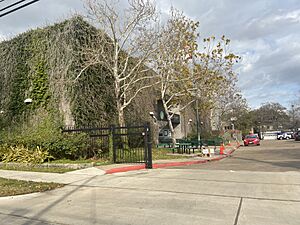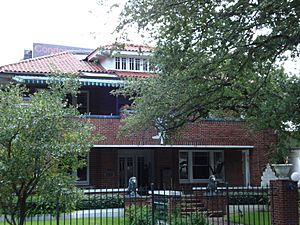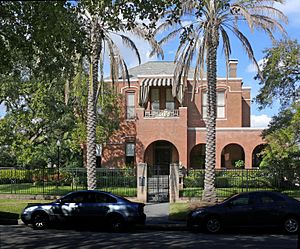Montrose, Houston facts for kids
Quick facts for kids
Montrose
|
|
|---|---|
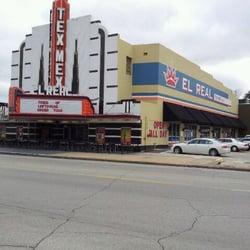
Former Tower Theatre (later Acme Oyster House)
|
|
| Country | |
| State | |
| County | Harris |
| City | |
| Time zone | UTC−6 (Central) |
| • Summer (DST) | UTC−5 |
| ZIP Codes |
77006, 77019
|
| Area codes | 713/281/832/346 |
Montrose is a lively neighborhood in west-central Houston, Texas, United States. It covers about 7.5 square miles (19.4 square kilometers). This area is also known as Neartown.
Montrose is famous for its cool art scene, amazing food, and fun nightlife. It's a very diverse place with old mansions, charming bungalows, and small cottages. These homes are found along streets lined with trees. People sometimes call Montrose the "Heart of Houston."
Contents
History of Montrose Neighborhood
Montrose was planned as a community in the early 1900s. Developer J. W. Link wanted it to be a "great residential addition." He planned wide boulevards with nice landscaping. Link even built his own home in Montrose, which is now part of the University of St. Thomas. A streetcar line, called the Montrose Line, ran through the neighborhood. Montrose was first mapped out in 1911.
In 1926, the Plaza Apartment Hotel opened on Montrose Boulevard. It was Houston's first apartment hotel. Many important Houston leaders lived there, including Dr. Edgar Odell Lovett, the first president of Rice University. The hotel was designed to look like the Ritz-Carlton in New York.
Montrose in the 1960s and 70s
During the 1960s and 1970s, Montrose became a center for the counterculture movement. You could find street musicians, alternative community centers, and artists’ studios. The corner of Montrose and Westheimer was a common spot for protests against the Vietnam War. People sold underground newspapers like Space City! in the area.
Radio station KPFT began broadcasting in 1970. It was part of the Pacifica Radio network. Other stations like KLOL and KILT also started in Montrose. KPFT's transmitter was bombed twice by a local group. This made it the only radio station in U.S. history to be forced off the air.
The artistic vibe of Montrose led to the Westheimer Colony Art Festival in 1971. This later became the Westheimer Street Festival.
Montrose Today: Growth and Change
Since the 1990s, Montrose has become more modern and upscale. Many homes have been remodeled or rebuilt. Rents have increased, and new fancy shops and restaurants have opened.
Culture and Lifestyle in Montrose
Montrose is home to many different groups of people, including artists and musicians. You can find thrift stores, vintage shops, and many restaurants. On Montrose Boulevard and Westheimer Road, most old homes have been turned into businesses. However, you can still see historic bungalows and mansions in other parts of Montrose.
As of 2017, the nightclub Numbers was still a famous spot. It opened in 1978 and was very important for music in the 1980s. In 2016, Numbers was named one of the 50 Best Small Music Venues in America.
Museums in Montrose
The Menil Collection is a free museum on Sul Ross Street. It was started by John and Dominique de Menil to show their art collection. The famous architect Renzo Piano designed the Menil.
The Museum of Fine Arts, Houston is also nearby in the Houston Museum District.
Chapels and Architecture
The Rothko Chapel was also created by John and Dominique de Menil. It is a non-religious chapel located near the Menil. Inside, you can see fourteen large paintings by Mark Rothko. The artist helped design the chapel. Outside, Barnett Newman's sculpture, Broken Obelisk, stands in a reflecting pool. It is dedicated to Martin Luther King Jr..
The Chapel of St. Basil is on the campus of the University of St. Thomas. It was designed by Philip Johnson. The chapel has white stucco and black granite.
Economy and Services
Montrose has many large grocery stores for residents.
Consulates in Montrose
A consulate is like an embassy for a specific city. The Consulate-General of Norway is located in Montrose. The Consulate-General of the People's Republic of China in Houston was also in Montrose before it closed in 2019.
Parks and Recreation in Montrose
The Houston Greek Festival is held near the Annunciation Greek Orthodox Cathedral. This festival usually happens in the first week of October and has been a tradition for over forty years.
The Montrose Remembrance Garden is a memorial for victims of violent crimes. It was created in 2011 at California and Grant streets. Ervan Chew Park is a local park where dogs can play off-leash in a special area.
Education in Montrose
Colleges and Universities
Montrose is home to the University of St. Thomas.
The Houston Community College serves the Montrose area.
Public Schools in Montrose
Students in Montrose attend schools in the Houston Independent School District.
- Baker Montessori School (formerly Wilson Montessori School)
- MacGregor Elementary School
- Poe Elementary School
- Wharton Dual Language Academy
For middle school, students go to either Lanier Middle School or Gregory-Lincoln Education Center. All Montrose students attend Lamar High School.
The High School for the Performing and Visual Arts, a special magnet school, was in Montrose until 2019. The Arabic Immersion Magnet School moved into its old building in 2019.
Many of the public schools in Montrose have a long history. Montrose Elementary opened in 1906. Wilson opened in 1925, Lanier in 1926, Poe in 1928, and Wharton in 1929. Both Wharton and Wilson elementaries received fireplaces from Ima Hogg, a famous Texas philanthropist.
Private Schools in Montrose
The Annunciation Orthodox School is located in Montrose. Other private schools like The Kinkaid School and The Harris School were once in the area.
Public Libraries in Montrose

The Eleanor K. Freed-Montrose Neighborhood Library of Houston Public Library was located in a former church building. This building had a bell tower and a beautiful stained glass window.
In 2019, plans were made for a new library building. The old church-based library closed in March 2024 due to safety concerns. The new Freed-Montrose library is expected to open in December 2024.
Famous People from Montrose
Many notable people have lived in or been connected to Montrose:
- Carlos Correa - A professional baseball player.
- Clark Gable - A famous actor who studied acting here.
- Howard Hughes - His former home is now part of the University of St. Thomas.
- Lyndon Johnson - A former U.S. President who lived here while teaching high school.
- Annise Parker - A former Mayor of Houston.
- William Sydney Porter (O. Henry) - A famous author who lived here as a reporter.
- Daniel Quinn - Author of Ishmael.
- Ross S. Sterling - A former Texas governor whose mansion was moved to Montrose.


